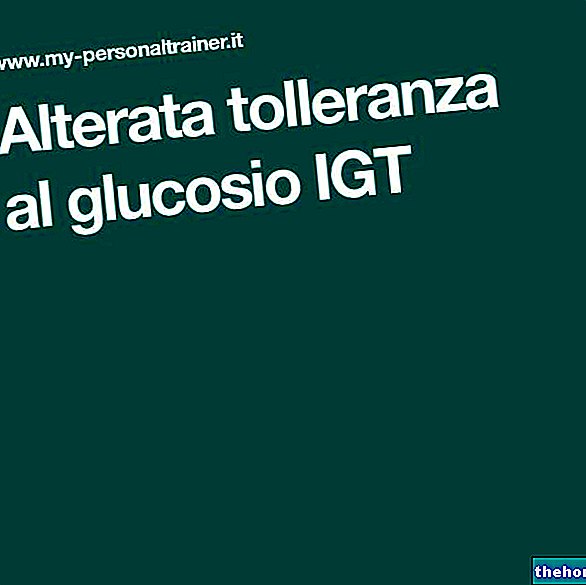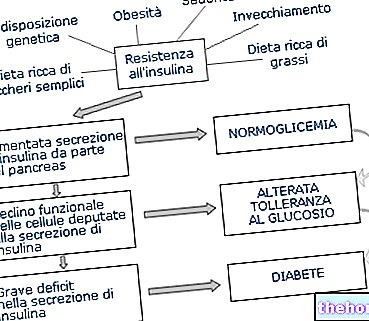Definition
Impaired glucose tolerance or IGT (acronym for Impaired Glucose Tolerance) is a condition in which the glycaemia - after two hours from the oral load with 75 grams of glucose - assumes values between 140 mg / dl and 200 mg / dl.
Diagnosis
The test used to diagnose impaired glucose tolerance is called OGTT or oral glucose load curve: after fasting for at least eight hours, a preventive glycemic test is performed on a small sample of venous blood; at the end of the sample, the patient he is invited to ingest a liquid meal based on 75 grams of glucose dissolved in 250-300 ml of water.
The glycaemia is then monitored at regular intervals, in order to reconstruct the temporal trend of the glycemic levels in the blood. The most indicative data is obtained 120 minutes after ingestion: if at this moment the glycaemia is between 140 and 200 mg / dl the glucose intolerance test is positive.
In the presence of IGT, fasting glycemic levels can be absolutely normal or only slightly increased; in the latter case we speak of altered fasting glycaemia or IFG associated with IGT.
Altered blood sugar a
fasting (IFG)
Altered tolerance
glucose (IGT)
Diabetes mellitus
(DM)
1999 WHO Diabetes criteria - Interpretation of Oral Glucose Tolerance Test - OGTT
* > (100 mg / dl according to the "ADA - American Diabetes Association)
Health Risks
Impaired glucose tolerance is characterized by an objective abnormality of glucose metabolism. Since the glycemic values still remain below the threshold level necessary to formulate the diagnosis of diabetes, this anomaly has overall limited dimensions.
Even if it is "only" a pre-diabetic stage, the finding of IGT should not be underestimated. Compared to the euglycemic subject, in fact, the patient with impaired glucose tolerance is exposed to a greater cardiovascular risk, especially as regards concerns ischemic heart disease.
Impaired glucose tolerance is typically associated with metabolic syndrome, characterized by the presence of insulin resistance, compensatory hyperinsulinemia, hypertriglyceridemia, reduced HDL cholesterol levels and arterial hypertension. The common thread, as well as the main causative agent, of these diseases is overweight , especially when the excess fat is concentrated at the visceral level.
What to do
The main intervention strategy to bring postprandial glycemic levels back to normal is therefore based on "approaching or maintaining a healthy weight. This result is obtained by limiting the intake of calories, carbohydrates, especially simple ones, and saturated fats, while increasing the consumption of fresh vegetables.
To learn more, read: Example diet for type 2 Diabetes Mellitus
Physical activity is also very important; if after a sin of gluttony a brisk walk can help to promote the activity of the brown adipose tissue, walking briskly for thirty minutes a day (or at least for 4 minutes). times a week), and preferring a few healthy flights of stairs to the lift, is an extraordinarily effective strategy for preventing diabetes and improving general well-being and lipid profile (cholesterol, triglyceridemia, etc.).
To learn more, read: Physical activity and Type 2 diabetes
In the presence of an "impaired glucose tolerance" some supplements may also be helpful, in particular those based on vegetable fibers, the use of which must be previously discussed with your doctor.
To learn more, read: Medicinal Plants and Diabetes
Furthermore, if he deems it appropriate, the professional can recommend the use of real drugs, capable of acting both on glycemic levels and on excess weight (see acarbose and orlistat).




























